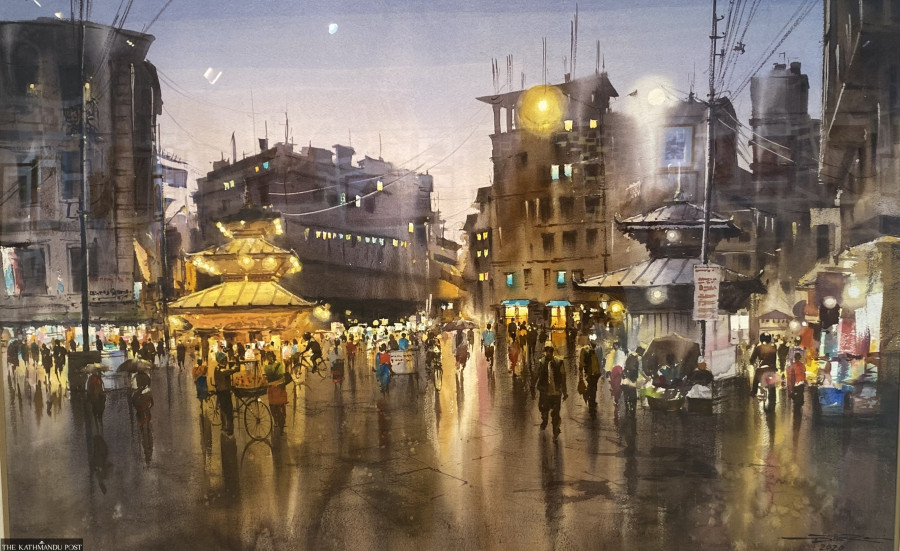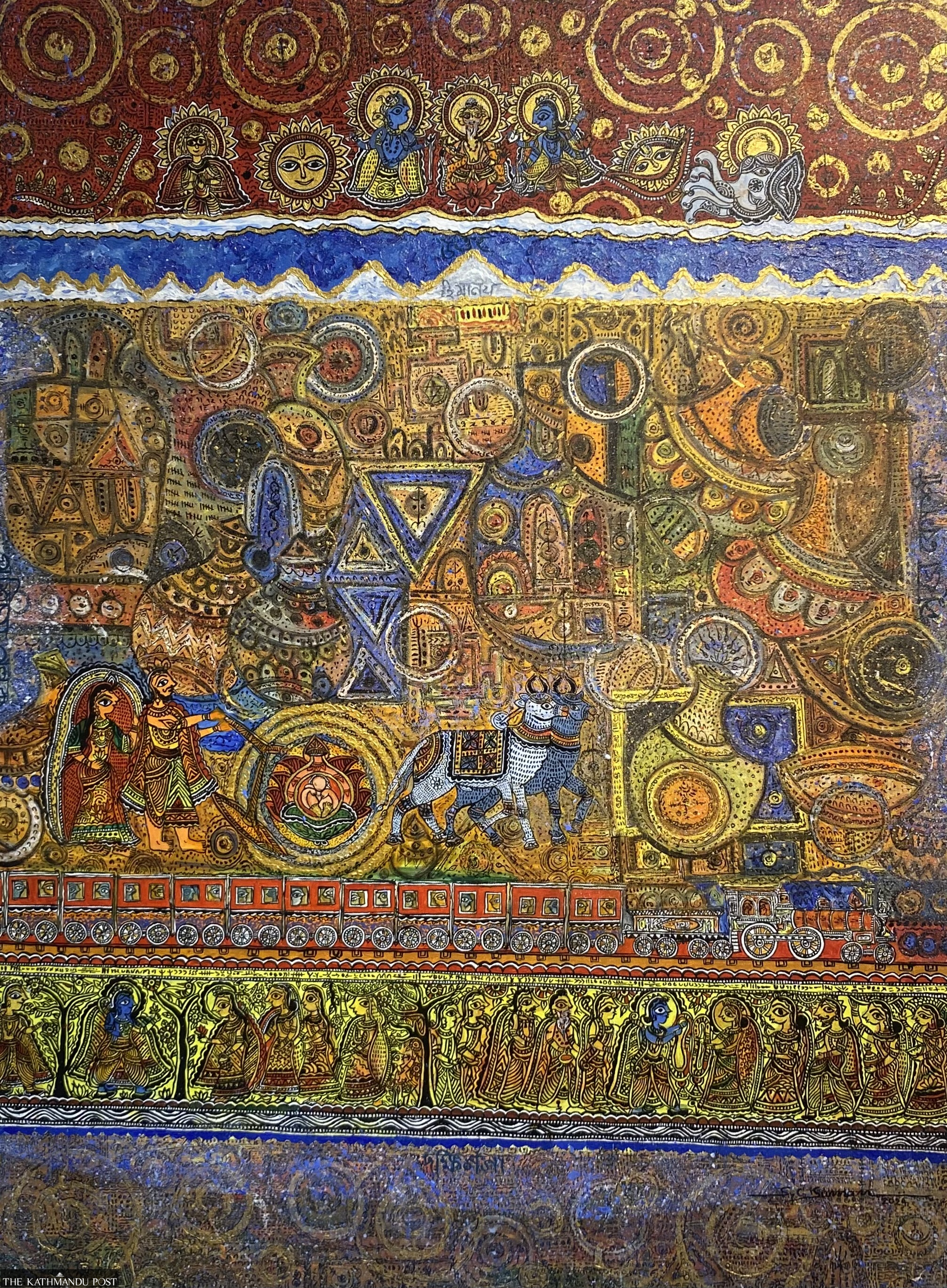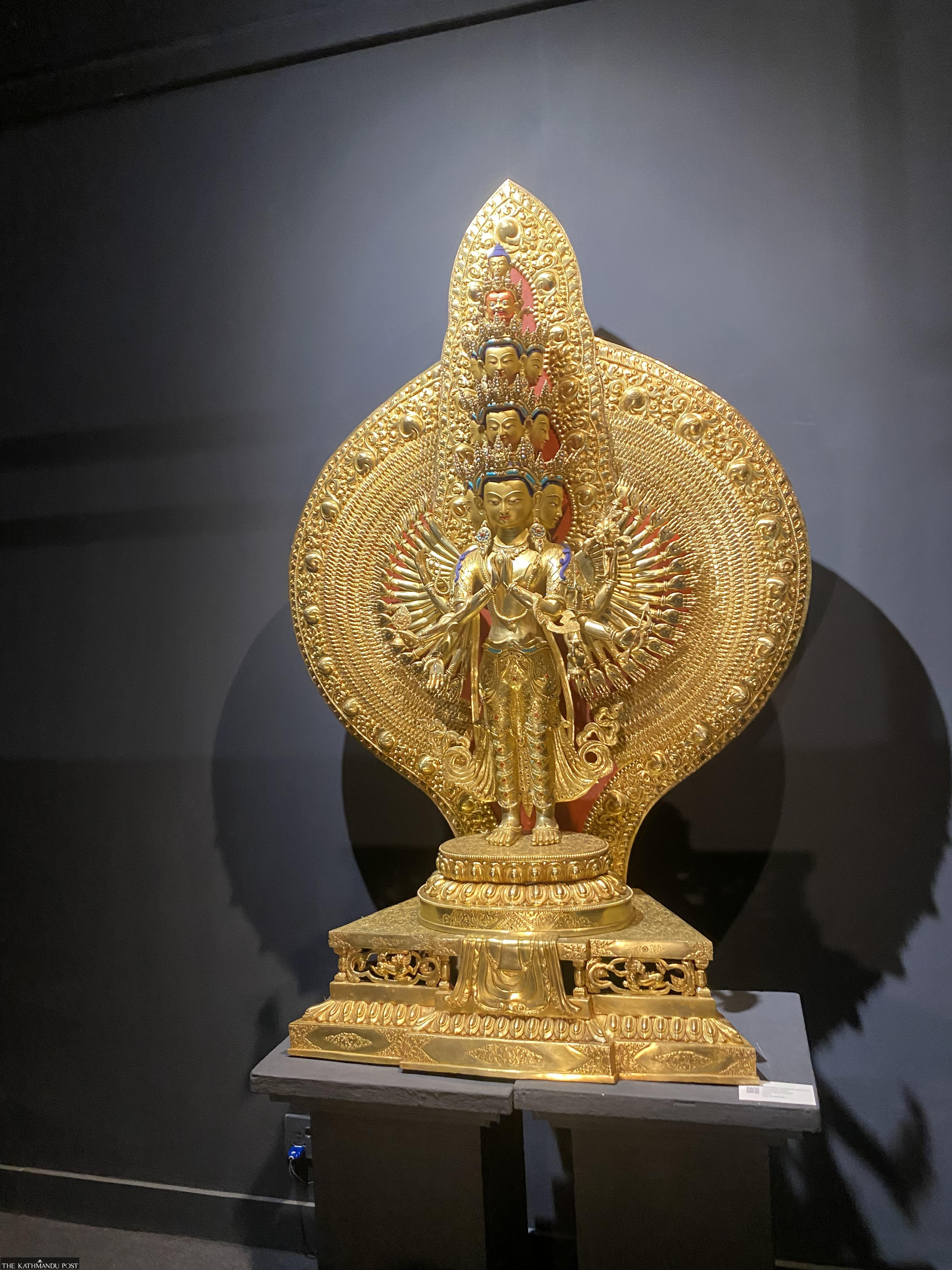Arts
Divine inspiration
The exhibit explores timeless fusion of heritage and creativity as Nepal’s century-old mythology unfolds in a captivating tale of fine and contemporary artistry.
Khushi Das
Accompanied by soothing, almost hypnotic music, the exhibition has Dal Bahadur Rai’s ‘Annapurna Temple at Night’ as one of its initial installations. The work portrays the nightlife of Indrachowk, Kathmandu. The artwork embodies meticulous attention to detail, with each brushstroke carefully layered to form the subtle interplay of light and shadows.
Rai understands the contrast between the figures and the principle of holography, with very little pigment yet hundreds of shades.
‘Deities of Nepal-II’, currently on display at Nepal Art Council (NAC), goes beyond just displaying art—it represents the essence of Nepal, a tribute to its diverse culture and mythologies and a profound commitment to preserving its artistic legacy. It is an extension of the ‘Deities of Nepal’ exhibition held in 2022.
With a collection of over 220 artworks, the NAC has explored the opportunity to showcase the brilliance and authenticity of generations of artists who represent artistic expression in traditional Nepali culture.
This time, NAC has carefully picked the artworks from national and international artists—fine and modern, traditional and visual, metal and ceramic, clay and gold.

Bikash Ratna Dhakhwa, the General Secretary of NAC, says, “Deities have influenced our art and literature for a long time. After the success of our first ‘Deities of Nepal’ series, we are back again with the second exhibition.”
Blending traditional iconography and contemporary modern art, especially artists Uma Shah, Seema Shah, and Manish Dhoju, have polished their artworks to the point that they resonate with audiences without generational confinement.
Despite the fast technological and societal change, it is quite evident that century-old narratives and mythology continue to captivate the human imagination, upstaging exploration and experimentation.
You can see the effort, time, resources, research, and energy required to make these visually pleasing and equally meaningful artworks.
At first glance, SC Suman’s painting ‘Bhumija’ appears to be a jumble of colours and patterns, but a closer look reveals the guarded detail and precision behind every line.
‘Bhumija’ by Suman aroused my interest for a while. It depicts Sita’s birth narrative, adorned with the characteristic bright colours of Mithila art: red, yellow, and green. Because of its ability to connect viewers to centuries of traditions and storytelling, one must be ready to contemplate deeply before taking it in. Every corner is filled with relevant shapes, flowers, patterns, or animals that narrate the initial plotline of the Ramayana.
The exhibit’s Mithila paintings contain so many intricate details that one may spend a whole day contemplating them. Seema Sh ah’s ‘Krishna Leela’ was another work that captivated me.
Seema has carefully chosen pigments for her artwork, such as the different hues of green, red, and white. The work portrays the ethereal subtleties of Mithila art, incorporating small things like fish, lotus, tiles, and ancient structures and architecture.
By skillfully embodying these symbols, Suman and Seema have given their works of art layers of refinement and sophistication.
They clarify the artists’ apparent understanding that artworks portraying divinity are inextricably linked to our legacy, as their work mirrors centuries-old norms, beliefs, standards, values, tales, and practices.
The artworks here are so beautiful that it is very sad that this sector gets almost no support. Dhakhwa says, “The concerned ministry doesn’t pay any attention to what our artists are making and how advanced our works have become.” NAC hopes that with the diverse art collection presented at the exhibition, viewers will take something meaningful away.
On the other end of the spectrum, modern artists have succeeded in giving old stories and legends new life through their work by incorporating creative approaches. From dancing Bramhayani and Bhadrakali to the illustration of meditating Shiva, modern artists Sharad Ranjit, Sunil Ranjit and Hari Khadka have brought these classic tales to life with vivid colours, dynamic movements, and creative interpretations.
Paintings and a few ceramic structures occupy the first two stories, while remarkable scriptures and fine paintings that required hundreds of hours and millions of resources are found in the third story.
What sets this exhibition apart is not only its conceptual brilliance but also its inclusive embrace of diverse genres and artists. It stands as a beacon of cultural preservation, illuminating the richness of Nepal's artistic heritage without generational confinement.
Something new for Nepali exhibitions was the virtual reality experience by Fire Studios.
Within the black, dark walls on the top floor, you’ll find yourself in an immersive work projected onto the walls and floor, surrounding you completely with the digital projection of Lok Chitrakar’s ‘Lotus’.

As you stare at the immersive walls, you will hear a clear, calm voice that explains the main idea of the artwork. The scene was expertly created to be as immersive as possible, and even after prolonged viewing, it will continue to captivate you.
The floor projects the Oxford blue water below, where the lotuses—a sign of rebirth, strength, and resilience—open their blooms at the break of day.
Similarly, the Thangka artworks were created using traditional procedures, precisely conforming to the proportions of deities as outlined in Buddhist scripture. There was a lot of yellow, orange, blue, and red—some embellished with gold—that resembled scenes from Buddhist cosmology, mandalas, and other spiritual symbols.
The Thangka collection lacked modern or abstract paintings. Thangka artworks are supposed to be finely detailed and precise, yet incorporating symbolism into modern art would have been exciting.
The organisers made every effort to ensure that the growing collection of paintings, scriptures, and crafts didn't get lost among the many other artworks as they were given their own spaces.
The first painting on the upper floor by Nelson Ferreira, called ‘Mystic Splendor; Nocturnal Paintings of Kathmandu Valley; Platigleam, Painting without Paint’ has to be one of the more intriguing paintings I've witnessed. You have to put on the touch of your phone and hold it at your nose level with a torch facing the painting.
You will see the art gleaming at you.
However, it was a little difficult to admire the artwork on the upper floor due to insufficient ventilation and scorching heat. While the pitch-black walls were stunning in their elegance, the hall’s temperature was relatively toastier than that of other floors.
The final visit is to the first room across the entrance. It has taped photographs of Nepal's stolen art and their repatriation.
The assembled graphical timeline offers a historical summary of the arts that have been lost in Nepal. The NAC’s remarkable effort to preserve our heritage is evident and impressive.
You’ll see tradition infusing imagination and sacredness blending with creativity. All 162 artists have paid honour to Nepal’s ancient deities, giving great care, love, and precision to each brush stroke and chisel touch with a profound commitment to perfection.
But there is an unsettling reality to the status of Nepali art's economy in the marketplace.
Despite Nepal's great heritage in high craftsmanship, we rarely see the market putting effort into revolutionising art spaces in Nepal, making them better, more accessible, and reaching a larger audience.
Art preserves our heritage, bridging the gap between generations. We don’t do art just because it’s aesthetically pleasing; we do it because we are part of the human race. To sustain these traditions, cultures, tales, norms, changes, and artists in the field, the artworks must reach a larger audience.
The exhibition has garnered international acclaim for its beauty, craftsmanship, and cultural significance. By achieving global recognition, Nepali artisans elevate the profile of their craft and promote cross-cultural exchange and appreciation.
Deities of Nepal - II
Where: Nepal Art Council, Babarmahal, Kathmandu
Timings: 10:30 am to 5:00 pm
Entry: Free
Till June 10




 9.12°C Kathmandu
9.12°C Kathmandu











